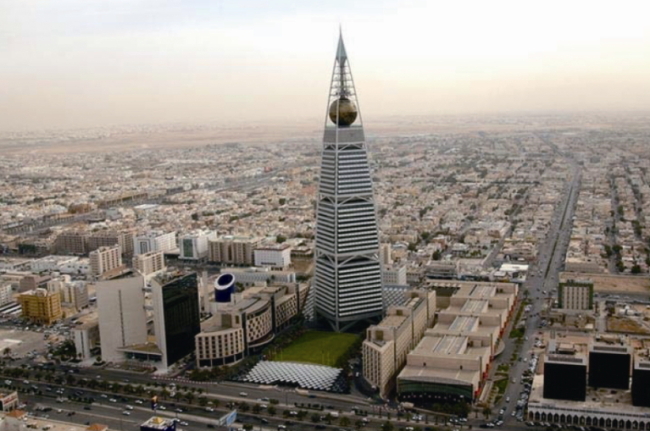Riyadh is the meeting place for the nation and the capital of the Kingdom of Saudi Arabia. It is characterized by its geographical location since it is located in the central part of the Kingdom. It is home for the government and all governmental divisions and major companies as well as foreign embassies in the Kingdom.
Riyadh encompasses the biggest universities and scientific institutes, and is characterized by the hundreds of entertainment centers and historical sites scattered within the area.
Riyadh unites modernity and the past through high modern buildings and architecturally unique constructions.

Faisalya Tower in Riyadh
High-quality infrastructure is found in a large number of its quarters. A circular network of roads links the whole city together along with highways that link it to the rest of the areas. A huge airport is located to the northeast of Riyadh.
Riyadh hosts the most important of gulf, Arab and international conferences on a regular basis. Hundreds of exhibitions and conferences known internationally are also held there, such as:
― Medical conferences (ophthalmology, dental and medical equipment)
― Jaytex Exhibition
― International book fair
― International motor show
Riyadh includes a host of prominent shopping malls where the best international brands are available. Al Olia Street and Al Tahila Street are considered among the most important locations where high-class restaurants and boutiques are found. Numerous luxurious compounds are found along King Fahd Street such as Kingdom Commercial Center and Al Faisalya Commercial Center which include a group of world-class restaurants.
Popular markets are also found in Al Zil market where visitors can see the history.
Visitors can shop as much as they like, for there are a lot of commercial activities that sell and manufacture traditional products such as swords, antiques and carpets.
● Madain Salih
In 2008, the archaeological site of Al-Hijr (Madin Slih) was the first UNESCO World Heritage property in Saudi Arabia to be inscribed. Formerly known as Hegra, it is the largest conserved site of the civilization of the Nabataeans, south of Petra in Jordan.
It features well-preserved monumental tombs with decorated facades dating from the first century B.C. to first century A.D. The site also features some 50 inscriptions of the pre-Nabataean period and some cave drawings. Al-Hijr bears a unique testimony to Nabataean civilization.
With its 111 monumental tombs, 94 of which are decorated, and water wells, the site is an outstanding example of the Nabataeans’ architectural accomplishment and hydraulic expertise.
● Mosque in Mecca
As the city of Mecca is the holiest place in the entire Muslim world, Saudi Arabia is no stranger to travelers. For thousands of years, pilgrims have flocked to the country to worship at the Grand Mosque and the Kabaa shrine. The city, in the West of the country, welcomes some 2 million Muslims a year, who come as part of the Hajj pilgrimage, which makes up one of the five pillars of Islam.
● Al-Masmak Palace
Al-Masmak was the starting point for King Abdul Aziz to recover the capital of his grandfathers. The palace was renovated and transformed into a public museum. The word “masmak” means thick, high inaccessible building, and this is applicable to Al-Masmak, which is a strong square fortress with high towers of thick walls. Al Masmak was used for a long time as arsenal before being transformed into a museum.
The gate is on the western side of the palace and made of palm date and tamarisk wood. At the middle of the gate there is small door, which lets through only two persons at a time. The door to this day bears the scratch of the broken spear of King Abdul Aziz when he attacked the palace.
The mosque is to the left side when entering the palace. The mosque is a large, multi-pillar room with wall racks for Quran, Miharab and ventilation openings in the ceiling and walls.
The court is opposite the entrance of the palace. It is a rectangular hall with a kitchen for coffee making.
The well is in the northeastern side of the palace. Water was withdrawn with a special mechanism installed at the well opening.
At each corner of the palace are 18-meter-high cylindrical towers with stairs and two wooden ladders each. Each tower’s walls are 1.25 meters thick. At the bottom, there are special places for shooting. There is also a square tower at the center of the palace called Al Morabaa, with the upper terrace overlooking the main courtyard. The courtyard is surrounded by rooms, which connected with each other from inside and have stairs leading to the first floor and roof.
The first floor comprises of rooms overlooking the main palace courtyard, and some of these rooms were used for residential purposes. Now the whole palace is a museum and ready to receive all those who are interested in history.
The museum consists of one hall, which contains pictures, maps, maquette and other old tools. Also shown in this hall is a map of Riyadh wall with its gates, a map of King Abdulaziz military campaigns and some of the old weapons.
● National Museum of Saudi Arabia
The National Museum of Saudi Arabia is another top attraction. It is set in the sweeping grounds of the King Abdul Aziz Historical Area. It provides an extraordinary introduction to all aspects of the Kingdom’s natural, religious, historical and social heritage. The museums vast displays draw on various national resources, the most impressive of which is the Riyadh Museum for History and Archaeology. It occupies 28,000 square meters of floor space and consists of eight main display halls which provide an epochal sweep of Arabian history. The museum uses state-of-the-art interactive technology, including small-screen cinemas and audio commentaries in Arabic and English, all of which make it suitable for children and adults alike.

![[Exclusive] Korean military set to ban iPhones over 'security' concerns](http://res.heraldm.com/phpwas/restmb_idxmake.php?idx=645&simg=/content/image/2024/04/23/20240423050599_0.jpg&u=20240423183955)

![[Graphic News] 77% of young Koreans still financially dependent](http://res.heraldm.com/phpwas/restmb_idxmake.php?idx=645&simg=/content/image/2024/04/22/20240422050762_0.gif&u=)


